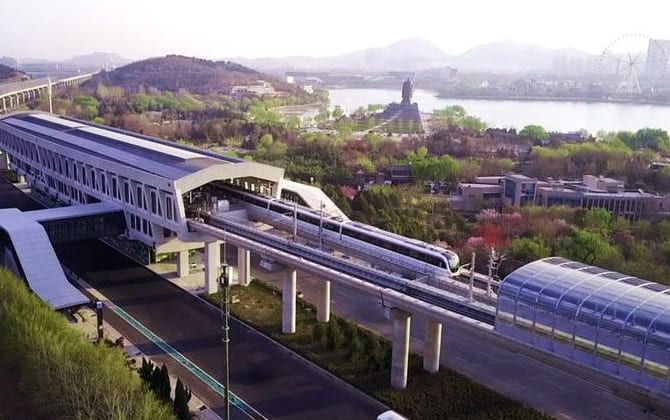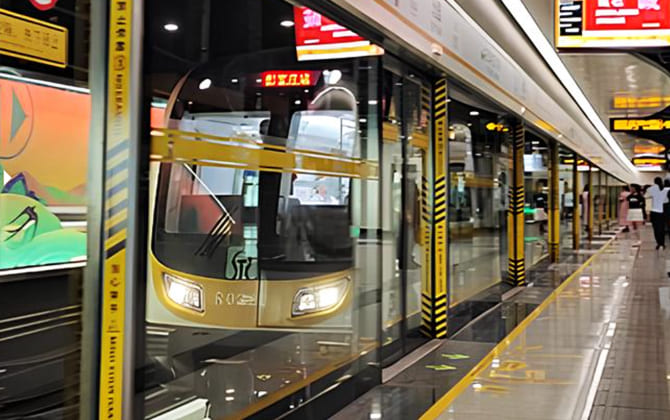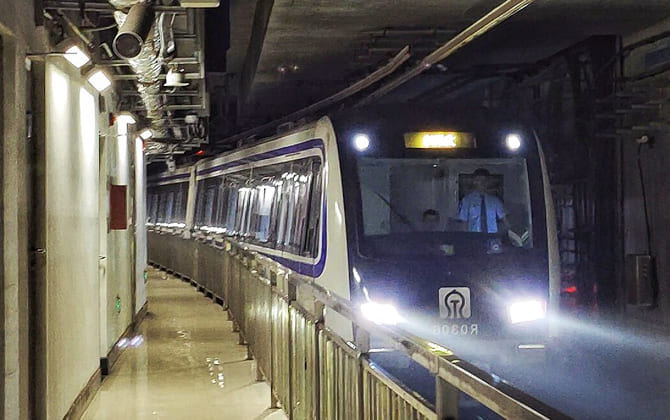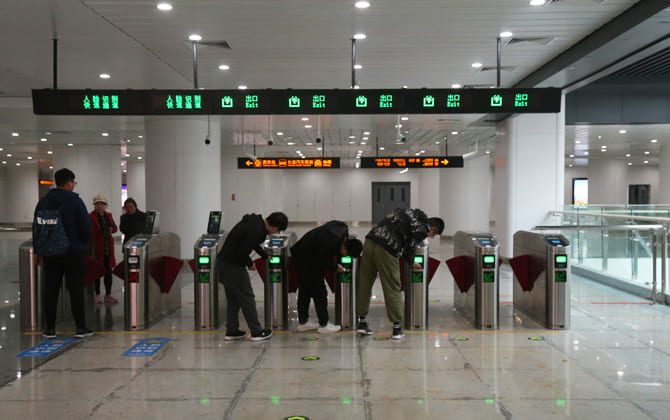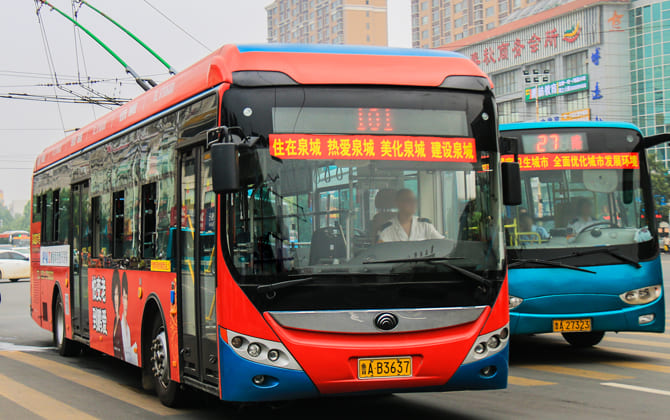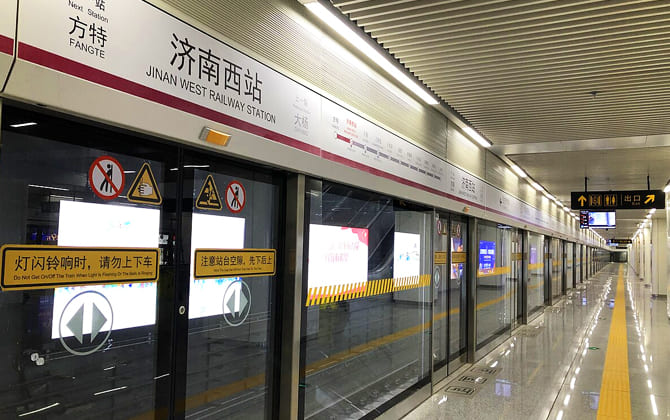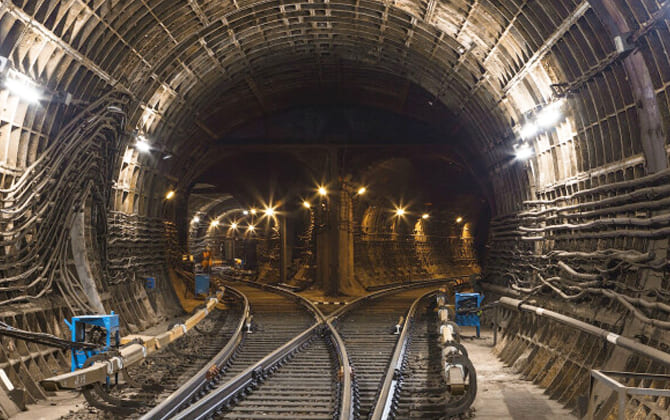Jinan Metro is the rapid transit system for Jinan, the capital of Shandong Province in China. Opened in 2019, it now operates three lines with 46 stations and nearly 100 km (about 62 miles) of track. The network connects downtown business districts, university areas, and key hubs such as Jinan East and Jinan West railway stations. This 2026 guide covers the current metro map, line overviews and photos, the full timetable and operating hours, ticket prices and fare rules, routes and transfers to buses, trams, and the airport, as well as parking, station facilities, usage tips, safety, notable facts, history, and future expansion plans. Use it to navigate the Jinan subway across the “City of Springs.”
Jinan Metro Map
The Jinan Metro Map (2026) shows the three active lines—Line 1, Line 2, and Line 3—covering the city. Each line is color-coded (for example: Line 1 is purple, Line 2 yellow, Line 3 blue), and the map includes all stations and interchange points.
Jinan Metro Map showing different lines. Click on the map to enlarge it or download the Jinan Subway map in PDF format.
Jinan Metro Lines and Photos & Complete Stations List
Jinan currently has three metro lines in operation. Below is a breakdown of each line with route, length, key stations, and the full station list.
Line 1 (Purple) – Industrial Technology Research Institute ↔ Fangte. A north–south line opened on April 1, 2019. Length: 26 km (16 miles). It serves western Jinan (Changqing, Shizhong, Huaiyin) and includes West Railway Station, a major high-speed rail hub. Transfer: Line 2 at Wangfuzhuang.
Stations: Industrial Technology Research Institute – Innovation Valley – Garden Expo – University Town – Ziwei Road – Zhaoying – Yufuhe – Wangfuzhuang – Dayang – West Railway Station – Fangte.
Line 2 (Yellow) – Wangfuzhuang ↔ Pengjiazhuang. An east–west line opened on March 26, 2021. Length: 36 km (22 miles). It runs through Lashan, the Old Town, East New District, and Tangye New City, linking the western suburbs to the eastern outskirts. Notable stops: Jinan Railway Station North (the main downtown rail hub) and West Erhuan Road (near the exhibition center). Transfers: Line 1 at Wangfuzhuang; Line 3 at Bajianbu (also written Bajianbao).
Stations: Wangfuzhuang – Lashan South – Lashan – West Erhuan Road – Laotun – Baliqiao – Yikang Road – Jinan Railway Station North – Jiluo Road – Shengchan Road – Beiyuan – Lishan Road – Qilibao – Zhudian – Bajianbu – Jiangjiazhuang – Fenghuang Road – Baoshan – Pengjiazhuang.
Line 3 (Blue) – Longdong ↔ Tantou (extended to Jichangnan). Opened on December 28, 2019; extended in November 2024. Initial length: 21.5 km (13 miles). The line connects Jinan East (high-speed rail) and Olympic Sports Center via Lixia and Licheng. After the Phase II extension to Jinan Yaoqiang International Airport, the route is about 34 km (21 miles) with five new stations (total 18). Transfer: Line 2 at Bajianbu. Future interchanges are planned with Line 9 at Wangsheren North and Line 8 at East Railway Station.
Stations (Phase 1): Longdong – Mengjiazhuang – Long’ao Mansion – Olympic Sports Center – Ligeng Road – Dingjiazhuang – East Huayuan Road – Bajianbao – Zhangmatun – Wangsheren – Peijiaying – East Railway Station – Tantou. Phase 2: continues beyond Tantou toward the airport (including Qujiazhuang and Airport South/Jichangnan).
All lines use modern electric trains. Lines 2 and 3 run 6-car sets; Line 1 currently uses 4-car sets that can be extended to 6. Stations provide bilingual signage and announcements, and transfers are clearly marked. Use the ordered station lists to confirm direction of travel.
Jinan Metro Timetable & Operating Hours
Jinan Metro runs daily with reliable hours from early morning to late evening. Below are the first and last train times and typical frequency.
Jinan Metro Timings Today
Service usually runs from about 06:00 to roughly 22:30–23:00, depending on the line. The metro operates every day, including weekends and holidays. During major events, hours may be extended by announcement.
Peak times are 07:00–09:00 and 17:00–19:00 on weekdays. Trains are most frequent then. Midday and late evening have slightly longer intervals. Service is continuous—no midday shutdown.
Always check the first/last train times posted at your station so you don’t miss the final departure.
Metro Opening & Closing Hours
Opening: All three lines start around 06:00. First trains leave the termini at or just after 06:00 (e.g., Line 1 from Industrial Technology Research Institute; Line 3 from Longdong and from Tantou; Line 2 from Wangfuzhuang and from Pengjiazhuang).
Closing: Line 1 runs to about 22:00. Line 2’s last departures are around 22:00–22:20, with final arrivals near 22:50. Line 3 runs latest: after the airport extension, the last Longdong → Airport South train is at 22:06, and the final Airport South → city train is at 23:10, arriving near midnight at Longdong.
Most stations finish service by about 22:30, except on Line 3, which can run to around 23:30 for airport connections. Gates close a few minutes after the last train. For late trips, start by about 22:00 (or 23:00 on Line 3) to be safe.
First & Last Train Times
Exact first and last trains vary by station and direction. Here are clear examples.
- Line 1. First trains leave both Industrial Technology Research Institute and Fangte at 06:00. The last train near the downtown end (West Railway Station area) passes around 22:02. The final departures from each terminus are about 21:30, so most Line 1 stations close by about 22:30.
- Line 2. First trains depart at 06:00 from Wangfuzhuang (west) and Pengjiazhuang (east). Last eastbound from Wangfuzhuang is 22:00; last westbound from Pengjiazhuang is also 22:00. Mid-line stations see later times as those last services pass through. For example, Lashan South may have its last westbound at 22:49. By about 22:50–23:00 the final trains reach the ends and service finishes.
- Line 3. First trains are at 06:00 from Longdong and, after the airport extension, around 06:00 from Airport South as well. Last full-route services run later than other lines: Longdong → Airport South departs 22:06; Airport South → Longdong departs 23:10 and arrives near midnight. Tantou now functions as a turn-back for some daytime trips (“large/small route” operation). After 20:00, all remaining trains run the full length to the airport. Practically, the last train leaving the airport for downtown is just after 23:00.
For your exact station, check the platform timetable for first and last departures in each direction. If you need to transfer late at night, confirm the connecting line’s last trains. The network is coordinated, but avoid tight connections near closing time.
Metro Frequency – Train Intervals
Peak hours. About every 7–8 minutes on all lines. Line 1 runs roughly every 7 minutes 45 seconds at 07:00–09:00 and 17:00–19:00. Line 3 is about every 7 minutes at rush.
Off-peak. Typically every 8–10 minutes. Line 1 is about 9 minutes. Line 3 averages ~8.5 minutes. Line 2 is similar—around 8 minutes at peak and up to 10 minutes off-peak.
Late evening. Intervals may widen to about 10–15 minutes after 21:00 as trains return to depots. Service still ends around 23:00, so waits remain short.
All stations have real-time “Next Train” displays. The Jinan Metro app also shows live arrivals—useful for timing your trip.
Jinan Metro Ticket Prices & Fare 2026
Jinan Metro uses distance-based pricing. There are no unlimited day passes—each trip is charged by how far you travel. Fares are low: most rides cost ¥2–¥6 (about $0.28–$0.85).
Metro Ticket Types & Day Pass
Single-Journey Ticket (token). One-way, same-day use. Tap to enter, insert to exit. Not reusable. Typical fare: ¥2–¥6 (~$0.28–$0.85), based on distance.
Rechargeable Smart Card (“Quanchengtong”). Stored-value card for metro and buses. Tap in/out; fares auto-deducted. About 20% off when paying by card or official app. New cards are issued at station service counters (a small card cost or deposit, often around ¥20 ≈ $2.80, may apply). No daily fare cap.
Mobile ticketing (QR/app). Use the Jinan Metro app or WeChat/Alipay transit code. Same ~20% discount as the smart card. Jinan also supports optional registered face-payment, but QR/card is simplest.
Other tickets. No day passes or multi-day passes. Concessions are common: for example, children under 1.3 m often ride free with an adult; local student discounts may apply.
Buying Tickets & Using the Metro Card
Buying. Every station has bilingual ticket machines. Select your destination, confirm the fare, pay (cash or mobile pay where available), and receive a green token. For a Quanchengtong card, visit the Customer Service Center to get a card and add value; later top up at machines, counters, or in the app.
Using gates. Tokens: tap to enter, insert at exit. Card/QR: tap or scan at entry and again at exit so the system calculates distance and deducts the correct fare. Staff can resolve scan errors or underpaid trips.
Charged on total distance from entry to exit (transfers within the system don’t add extra fees). Exit and re-enter starts a new trip.
- ¥2 (~$0.28) for the first 5 km (≈3 miles)
- ¥3 (~$0.42) for 5–10 km (3–6 miles)
- ¥4 (~$0.56) for 10–15 km (6–9 miles)
- ¥5 (~$0.70) for 15–22 km (9–14 miles)
- ¥6 (~$0.85) for 22–29 km (14–18 miles)
- Over 29 km (18 miles): add ¥1 (~$0.14) per additional 9 km (≈5.6 miles)
Most city trips fall in the ¥2–¥6 (~$0.28–$0.85) range. The longest single ride today—about 36 km (≈22 miles) end-to-end on Line 2—costs roughly ¥7 (~$1.00).
Tip. With the ~20% e-payment discount, a ¥4 (~$0.56) trip costs ~¥3.2 (~$0.45).
Example. Jinan West Railway Station → Jinan East Railway Station is ~26 km (≈16 miles). A token is ~¥6 (~$0.85). With card/QR it’s ~¥4.8 (~$0.70). A taxi for the same distance can be ¥80+ (~$11+).
Routes & Connections
Jinan’s transit network is tightly integrated, with the metro as the backbone and buses/BRT filling the gaps. You can connect at most stations to city buses or BRT corridors for areas not yet on rail. The same Quanchengtong card works on metro and buses, so transfers are seamless and discounted.
Connections with Bus, Tramways & Metro to Airport
- Bus & BRT. Nearly every metro station has bus stops at the exits. West Railway Station (Line 1) links to many city routes and the long-distance coach station. Jinan Railway Station North (Line 2) has immediate bus and taxi access. BRT corridors use dedicated lanes—some with modern trolleybuses—and intersect the metro for fast transfers. Examples include Route K9 connecting with Line 2 and routes near Wangsheren (Line 3) and West Guodian that align with BRT services. City buses are frequent and inexpensive at about ¥1–¥2 (≈$0.14–$0.28) per ride. Terminus stations such as Fangte (Line 1) and Pengjiazhuang (Line 2) have bus terminals for onward travel.
- Tramways & new modes. There is no city-center streetcar yet. A suburban light rail/tram in Jiyang district is under construction, with the first low-floor trams. Jinan is also piloting a “SkyShuttle” automated people mover in the High-Tech East Zone to serve corridors beyond heavy metro lines.
- Metro to the airport. Jinan Yaoqiang International Airport (TNA) sits about 33 km (21 miles) northeast of downtown. Since November 2024, Line 3 extends to Jichangnan (Airport South), giving a direct metro link. Jinan East Railway Station → Airport South takes about 21 minutes; Longdong → Airport South is roughly 50 minutes. Airport South is adjacent to the terminals, with a short walk or shuttle; full integration with the new Terminal 2 transport hub is planned.
- Airport buses & taxis. Airport Shuttle Buses still run citywide (e.g., Line 3 from Jinan West Railway Station) at about ¥20 (≈$2.80), every 30–60 minutes. The metro is usually cheaper—about ¥6–¥7 (≈$0.85–$1.00) for many airport trips—and more predictable. If you have heavy luggage or a late-night door-to-door need, a shuttle bus or taxi may be easier.
- Practical tip. Use the Quanchengtong card or QR code to hop between metro and bus with discounts, and follow station signage for the fastest bus/BRT transfer from your exit.
Overview of Public Transport
City buses. Jinan runs hundreds of routes, including K/B/T prefixes for express, BRT, or trolleybus lines. Typical fares: ¥1 (≈$0.14) for standard routes, ¥2 (≈$0.28) for air-conditioned or K routes. Using the transit card usually gives ~10% off. Most buses run from ~05:30–06:00 to ~21:00–22:00, with a few night lines. Buses cover areas beyond the metro; BRT lanes help avoid traffic on key corridors.
Bus Rapid Transit (BRT). In service since 2008, with median lanes, platform-level stops, and high frequency. Lines such as BRT1 (and K-prefixed services) act like “rubber-tire trams,” complementing the metro on major corridors. Many routes are electric or trolleybus-operated.
Trolleybuses. Quiet, zero-emission buses powered by overhead wires, integrated into BRT and downtown corridors (e.g., parts of K9, K11). Ride and pay like regular buses.
Trams/Light rail. A modern tram line for Jiyang district is under construction. It will add rail coverage in the north and is expected to connect with future metro lines. There is no in-street tram in the city center yet.
Metro & rail hubs. The metro links Jinan Railway Station and the high-speed East/West stations to the city network, simplifying transfers to buses and BRT.
Taxis & ride-hailing. Readily available (DiDi, etc.). Meter starts around ¥10 (≈$1.40) for the first 3 km (≈1.9 miles). Useful for door-to-door trips, but slower in rush hour; the metro is often faster across town.
How to plan. Combine metro for the main leg and bus/BRT for the last mile. Use a local transit app, Baidu Maps, or Google Maps for door-to-door routes. Expect network expansions through 2027, reducing long bus rides over time.
Facilities & Services
Jinan Metro stations and trains offer clear signage (Chinese/English), elevators and escalators, accessible restrooms, customer service counters, vending machines, and real-time train displays. Most hubs add lockers, ATMs, and bike parking. Mobile payments and the Quanchengtong card work system-wide.
Metro Station Parking Charges Per Day
Park-and-ride is available at select suburban stations and transport hubs. Fees vary by location under a progressive pricing policy that favors short stays.
City center hubs (e.g., Jinan Railway Station, connected to Line 2’s Railway Station North): tiered half-hour billing—about ¥3 (≈$0.42) for the first 30 minutes, ¥4 (≈$0.56) for the next, then ¥5 (≈$0.70) per additional 30 minutes. Daily caps rise with longer stays: roughly ¥80 (≈$11.20) on day 1, ¥100 (≈$14.00) on day 2, and up to ¥120 (≈$16.80) per 24 hours from day 3.
Peripheral hubs (e.g., Jinan West on Line 1, Jinan East on Line 3, Daming Lake, Long-distance Bus Station): typically cheaper—about ¥1.5 (≈$0.21) for the first 30 minutes, then ¥2 (≈$0.28) per 30 minutes, with a common cap near ¥40/day (≈$5.60). Parking at suburban termini like Fangte or Pengjiazhuang is usually the best value.
Other stations: many inner-city stops lack dedicated lots. Outer/new-zone stations may provide parking with local district rates, often a few yuan per hour and a daily cap around ¥20–¥40 (≈$2.80–$5.60).
Short stops: some hubs without special drop-off lanes allow about 15 minutes free for quick pick-ups/drop-offs. Always check the posted board at lot entrances for exact rates and any free window.
Tips: to save money, park at a peripheral station and ride in. Popular lots (e.g., West Railway Station) can fill on weekdays—allow time to find a space and pay at machines on return. Most lots accept mobile pay or the transit card.
Cost range: from free (brief drop-off) to about ¥40–¥80/day (≈$5.60–$11.20) in most cases, with a strict upper cap of about ¥120/day (≈$16.80) at the priciest central hubs.
Passenger Amenities on Stations & Trains
Jinan Metro is new and well equipped. Stations and trains are designed for comfort, safety, and clear wayfinding.
At Stations: All stations are accessible. Elevators link street, concourse, and platforms. Tactile paving guides visually impaired riders. Signs and announcements are bilingual, with Braille on key signage.
Escalators & stairs. Multiple escalators and stairways connect levels. Stand right if you are not walking.
Customer Service Centers. Every station has a staffed counter for directions, card purchase/top-up, and assistance. English may be limited, but maps or station names work well.
Ticket machines. Self-service machines sell tokens and recharge cards. Interfaces switch to English. Cash is widely accepted; some machines support Chinese bank cards or mobile pay.
Restrooms. Most stations provide clearly marked toilets (usually in the unpaid concourse). Facilities are generally clean; carry tissues as paper may not always be stocked.
Shops & vending. Larger interchanges often have kiosks or convenience stores, plus drink/snack vending. Eating on trains is discouraged; water is fine.
Security & safety. Bag screening at entrances is standard, with X-ray and occasional metal detector/wand checks. Hazardous items are prohibited. Stations and trains are covered by CCTV, and platforms have emergency call buttons.
Information displays. Digital boards show next-train times and service notices. Public address messages, including last-train alerts, are in Chinese and English.
Environment. Stations are bright, climate-controlled, and well maintained. Cleaning is frequent year-round.
On Trains: Lines 2 and 3 run 6-car sets with longitudinal seating and spaces for wheelchairs or strollers. Priority seats are reserved for riders who need them. (Upcoming Line 4 trains are designed for very high capacity—up to 2,590 passengers per 6-car train—about 640 more than Line 2.)
Air conditioning. Cars are cooled in summer and heated in winter for a comfortable ride.
Passenger information. Route maps above doors and LED displays show current and next stops. Announcements are in Mandarin and English, including transfer info.
Doors & platform screens. All stations have platform screen doors (full- or half-height). Do not block train doors; chimes and warnings play before closing.
Cleanliness & decorum. Trains are kept clean. Avoid eating; water is acceptable. Let passengers exit before boarding and keep audio to headphones.
Other amenities. Newer fleets add more doors and grab poles for faster boarding and better standing room. Priority areas near car ends accommodate wheelchairs. No onboard restrooms; use station facilities. Mobile 4G/5G generally works in tunnels.
Safety onboard. Each car has emergency intercoms and fire extinguishers. Use emergency devices only when necessary.
First/last mile. Many stations provide bike parking or bike-share docks outside. Lost-and-found is handled at station offices; some newer trains add USB charging ports as fleets are upgraded.
How to Use Metro: Guide & Tips
Jinan Metro is easy to use. Follow local rules and you’ll ride smoothly.
Riding Rules & Safety Tips
- No dangerous items. Security screening is mandatory. Bags go through X-ray; liquids may be checked; large bags can be inspected.
- No smoking or open flames. The entire system is smoke-free.
- Eating & drinking. Don’t eat on trains. Water is fine. Keep the system clean.
- Queue & board. Stand to the sides of the doors, let riders exit, then board quickly. If it’s packed, wait for the next train.
- Escalators. Stand right; walk left.
- On board. Move to the center if you’re not exiting next. Hold handrails for stability.
- Priority seating. Offer seats to elderly, pregnant, disabled riders, and adults with infants.
- Luggage. Keep bags out of aisles and away from doors. Step off briefly at stops to let others out, then re-enter.
- Doors. Don’t lean on platform or train doors. Never block or force closing doors; obey the warning chime.
- Behavior. Keep voices low. Use headphones for audio.
- Emergencies. Use platform call buttons or the in-car intercom only when necessary. Follow staff instructions and announcements.
- Children. Hold hands on escalators and platforms. No running near the edge.
- Mind the gap. Platform screen doors help, but still watch your step.
- Security presence. Police and staff patrol stations and trains. If you need help, ask them.
Is Metro Safe? – Passenger Safety Overview
Yes, Jinan Metro is safe. The system meets high security and operational standards.
Security measures. All entrances have screening to block hazardous items. Security staff and police patrol busy stations. CCTV covers trains and platforms. Petty crime is uncommon, but keep bags in front and wallets secure.
Cleanliness & health. Stations and cars are cleaned and sanitized regularly. Ventilation and air-conditioning keep air quality comfortable. During health alerts, masks or checks may be introduced and are widely followed.
Reliability. Modern trains and signaling keep safe headways and smooth operations. There have been no major safety incidents since opening. Backup power supports lighting, and staff run regular emergency drills.
Emergency preparedness. Stations have alarms, extinguishers, clear evacuation routes, and signage. Platform screen doors prevent track falls and improve safety. Trains stop if obstacles are detected.
Night safety. Late services remain well lit and staffed. Jinan is generally safe, but stay aware when exiting late. Keep phones and valuables secure.
Solo travelers. Safe for locals and visitors of any gender. Cars have visible CCTV. Report any misconduct to staff or police.
Weather resilience. Tunnels and stations are built with waterproofing and drainage suited to Jinan’s spring-fed geology. Operations are designed to remain safe during heavy rain.
Interesting Facts & History
Jinan Metro is young but has an eventful story, with rapid growth and some unique features.
Second city in Shandong with a metro. Qingdao opened in 2015; Jinan followed in April 2019 with Line 1, joining China’s “metro club” later than many large cities.
Planning challenges. Early planning began in the 2000s but was delayed by the 2008 financial crisis and the need to protect Jinan’s famous springs. Engineers developed special tunneling methods to avoid lowering the water table. Construction began December 29, 2013.
Rapid rollout. Phase 1 built Lines 1, 2, and 3 in quick succession: Line 1 opened April 2019, Line 3 (Phase 1) in December 2019, and Line 2 in March 2021—covering ~96 km in just two years. The Phase 1 investment totaled ¥48.9 billion (≈$6.85 billion USD).
Costs & construction. Line 1 cost about ¥12 billion (≈$1.68 billion USD). Phase 1 included ~72 km underground and ~24 km elevated, balancing cost and function.
Technology firsts. Line 1 was China’s first with 3D facial-recognition payment at gates, with a false acceptance rate of just 1 in a million. Future lines (4, 6, 7, 8, 9) will use larger Type A trains, and Line 6 is planned to be fully automated (GoA4).
Ridership growth. By April 2023, monthly ridership reached 10.53 million (~350,000 daily), up 279% year-on-year. Daily ridership is expected to exceed 1 million within a few years.
Design & culture. Stations have unique interiors reflecting local culture, from spring-themed art to Yellow River motifs. Olympic Sports Center station has sports-themed décor, and Jinan East Railway Station is designed for large high-speed rail crowds.
Naming. Originally called R1, R2, R3 during planning, the lines were renumbered to 1, 2, 3 on opening. Future lines will continue sequentially to Line 9 under current plans.
Economic impact. The metro spurred development around new stations, especially in the East New District (Line 2) and western university areas (Line 1), supporting balanced urban growth.
Environmental integration. Lines 2 and 3 avoid spring protection zones. Specialized groundwater protection tech during construction preserved spring flow, a model for infrastructure coexisting with heritage sites.
Public reception. Initial skepticism has given way to civic pride. The metro is now seen as essential, with strong public interest in every new line’s progress.
From zero to three lines in two years, Jinan Metro is expanding quickly and is set to become a major urban rail system in China.
Future Expansions & Upcoming Metro Lines
Jinan is rapidly expanding its metro, with major projects underway to greatly increase coverage by 2026 and beyond.
Phase 2 construction (2020–2026). Approved in October 2020, Phase 2 adds 159.6 km of track across six projects: new Lines 4, 6, 7, 8, 9, plus Line 3 Phase 2 (airport extension, now complete). Most began construction in 2020–2021.
Line 4. An east–west route from Xiaogaozhuang (west) to Dongjia (east), via Pengjiazhuang. About 40.2 km (25 miles), 32–33 stations. Interchanges: Line 1 (West Railway Station), Line 2 (Lashan), Line 3 (Olympic Sports Center East), Line 8 (Fenghuang Road). Uses larger Type A, 6-car trains for 2,590 passengers. Expected to open by late 2026.
Line 6. A north–south arc linking Old Town, Daming Lake, Shandong University, East Railway Station, and the High-Tech Zone. About 39–40 km (24 miles), 33 stations. First stage (~22.9 km) planned to open by September 2026. Designed for full driverless GoA4 operation.
Line 7. North–south line on the east side, Phase 1 from new Jinan North Railway Station to Fenghuang Nanlu. About 30 km (19 miles), 22 stations. Serves northern developments and future connections to Line 3 and Line 8. Opening targeted for 2027.
Line 8. Eastern route, Phase 1 is 25.5 km (16 miles), 10 stations, with wider spacing—likely suburban or express metro. Links Xingcun area to Qingyuandajie, crossing Line 4 and Line 3 extension. Expected in 2026.
Line 9. Planned as a northwest–southeast “C” shape. Phase 1 under construction: 14.8 km (9.2 miles), 11 stations from Huanghenan’an to Maozhuang. Expected opening in 2026. Will interchange with Lines 3, 6, and 7.
Line 5. Mentioned in older plans as a possible ring line, but not in Phase 2. May appear in Phase 3.
Beyond 2026. By 2027, Jinan expects 8 operational lines (1–4, 6–9) totaling ~248 km. The city aims for 300+ km by 2030. Planned projects include Line 3 Phase 3 to the new airport terminal (Jichangbei) by 2027, a SkyShuttle people-mover in the High-Tech Zone by late 2026, and possible tram-train or commuter rail integration.
For travelers. By mid-2026, Line 4 is in test runs, Line 6’s tunnels are complete, and Lines 7 and 8 are under active construction. New lines will bring metro access to key sites: Thousand Buddha Mountain and Shandong Museum (Line 4), Jinan North Railway Station (Line 7), and Honglou commercial area (Line 6). By 2026–2027, many areas now reachable only by bus or taxi will have direct metro service, reshaping travel in the city.

